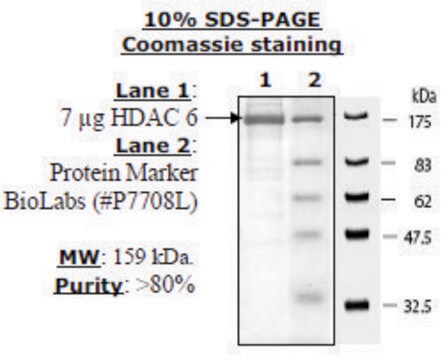CS1010
Histone Deacetylase Assay Kit, Fluorometric
sufficient for 100 assays (96 well plates)
Synonym(e):
HDAC Assay Kit
About This Item
Empfohlene Produkte
Verwendung
sufficient for 100 assays (96 well plates)
Qualitätsniveau
Versandbedingung
dry ice
Lagertemp.
−20°C
Angaben zum Gen
human ... HDAC1(3065)
Anwendung
Biochem./physiol. Wirkung
Leistungsmerkmale und Vorteile
Hinweis zur Analyse
Nur Kit-Komponenten
- Assay Buffer 20 mL
- Developer Solution 1.5 mL
- HDAC Inhibitor (Trichostatin A), 1 mM 50 μL
- HDAC Substrate, 20 mM 50 μL
- HeLa Cell Lysate 500 μL
- Standard (non-acetylated substrate), 4 mM 50 μL
Lagerklassenschlüssel
10 - Combustible liquids
Flammpunkt (°F)
188.6 °F - closed cup
Flammpunkt (°C)
87 °C - closed cup
Analysenzertifikate (COA)
Suchen Sie nach Analysenzertifikate (COA), indem Sie die Lot-/Chargennummer des Produkts eingeben. Lot- und Chargennummern sind auf dem Produktetikett hinter den Wörtern ‘Lot’ oder ‘Batch’ (Lot oder Charge) zu finden.
Besitzen Sie dieses Produkt bereits?
In der Dokumentenbibliothek finden Sie die Dokumentation zu den Produkten, die Sie kürzlich erworben haben.
Kunden haben sich ebenfalls angesehen
Artikel
Epigenetic modifications are thought to occur through two key interconnected processes—DNA methylation and the covalent modification of histones.
Unser Team von Wissenschaftlern verfügt über Erfahrung in allen Forschungsbereichen einschließlich Life Science, Materialwissenschaften, chemischer Synthese, Chromatographie, Analytik und vielen mehr..
Setzen Sie sich mit dem technischen Dienst in Verbindung.








